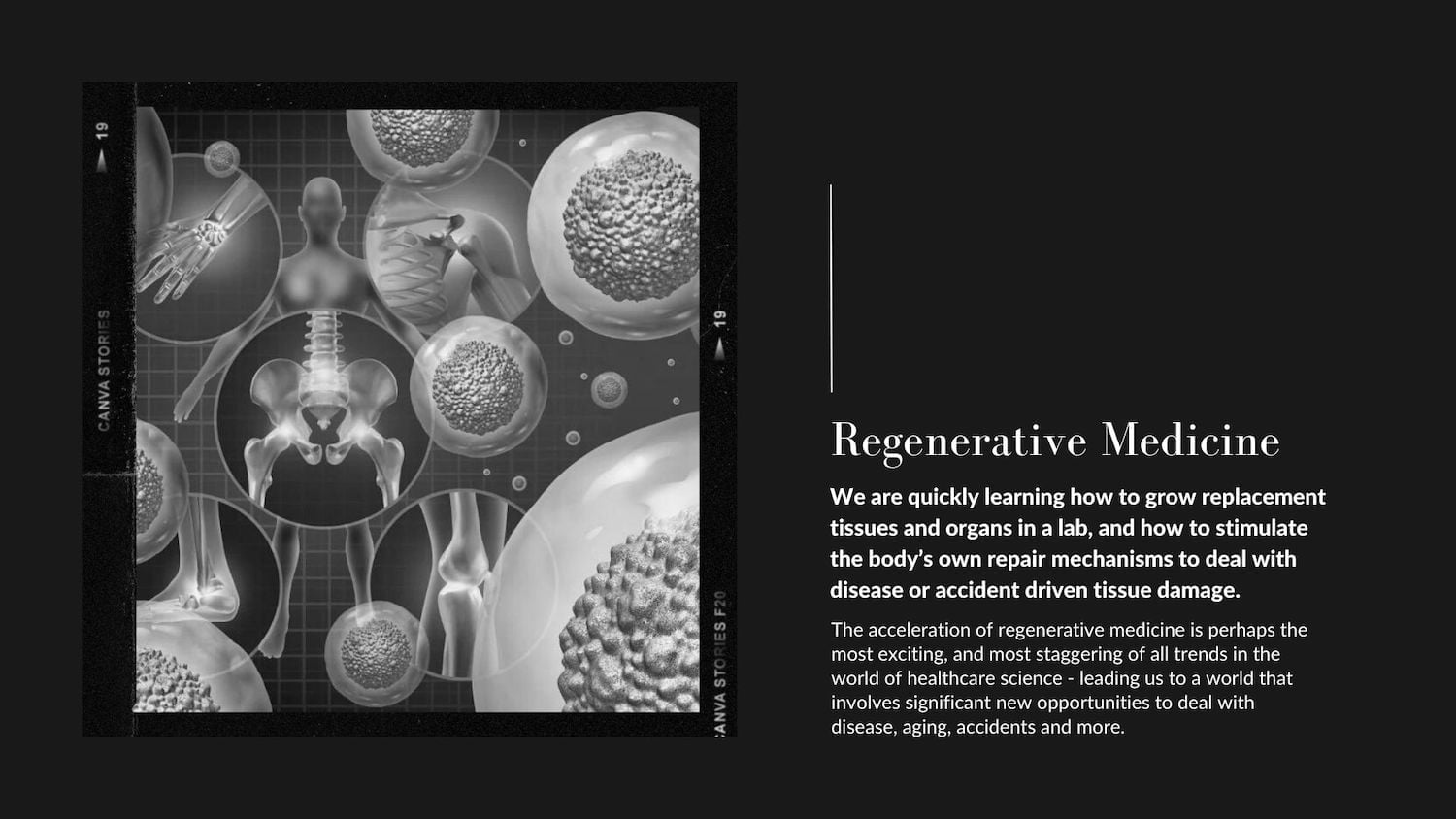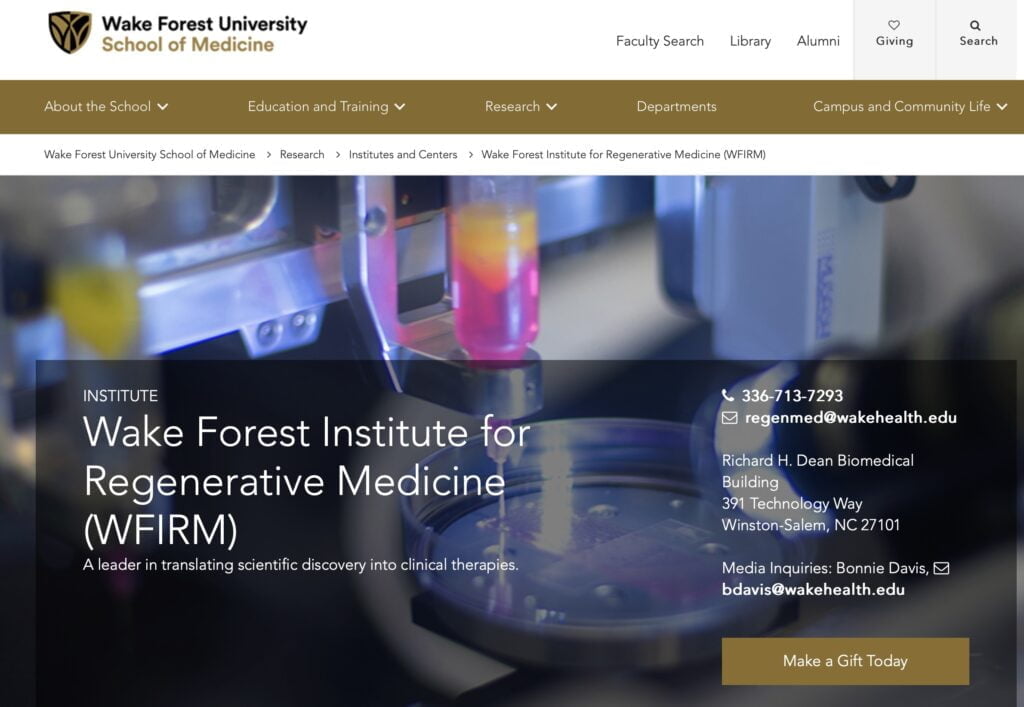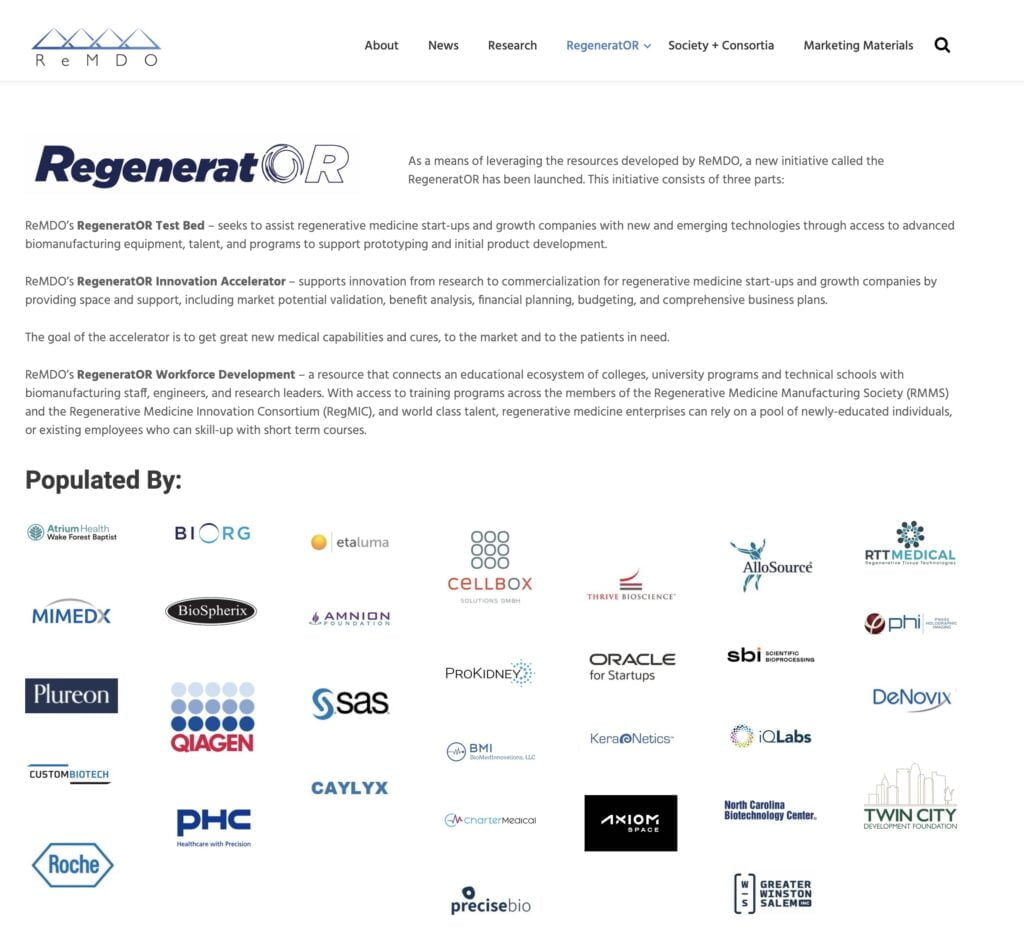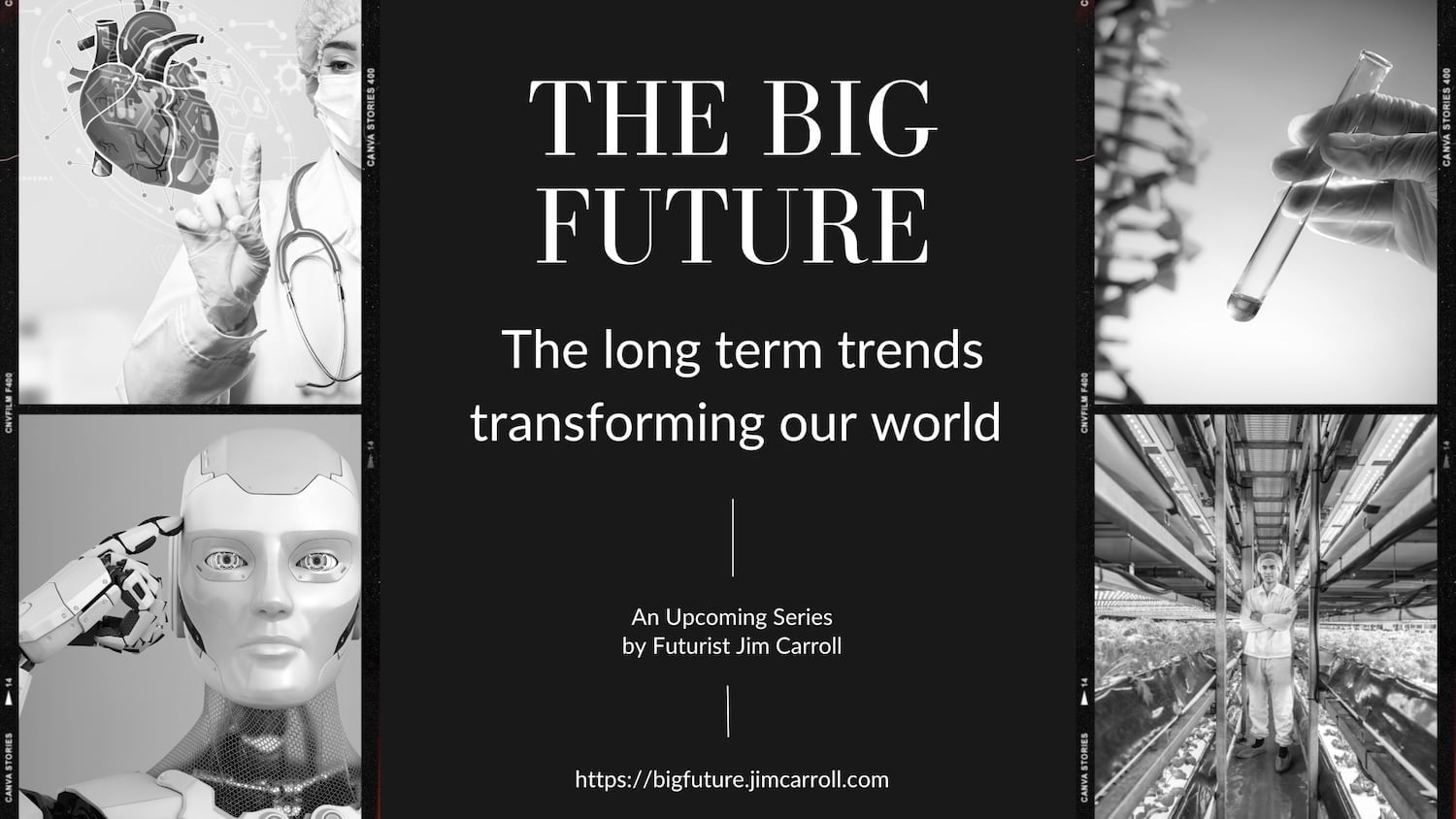We might live longer. We will see the reduction, elimination, or perhaps eradication of diseases. We’ll fix broken bones with lab-grown materials. We will grow human organs for transplant.
And in that context, we will be doing stuff tomorrow that seems like the science fiction of yesterday – because it is already starting to happen today!

We are on the edge of a fascinating new future in healthcare science overall, and yet one of the most fascinating and fast-moving trends has to do with the rapid advances involving what is known as “regenerative medicine.” This is one of the most important trends of our BIG Future – a series I’m running that identifies and takes a look at the most significant trends defining our tomorrow.
The Bottom Line
We are quickly learning how to grow replacement tissues and organs in a lab, and how to stimulate the body’s own repair mechanisms to deal with disease or accident-driven tissue damage. The acceleration of regenerative medicine is perhaps the most exciting, and most staggering of all trends in the world of healthcare science – leading us to a world that involves significant new opportunities to deal with disease, aging, accidents, and more!
What is it?
It is a trend that will help us to deal with so many of the things we have been unable to deal with despite the magic of healthcare science so far. A few quotes will help to put this trend into perspective:
Regenerative medicine harnesses the body’s amazing ability to heal itself, using cutting-edge technology to apply this regenerative power to prompt the body to recover from diseases previously uncured.”
A Look At Some Of The Companies Innovating In the Cutting-Edge Regenerative Medicine Field
14 October 2022, Dow Jones Newswires
The scope is far-reaching:
Some of the areas where regenerative medicine is being explored include:
Cardiovascular disease: Researchers are working on ways to use stem cells to repair damaged heart tissue, as well as developing lab-grown blood vessels and heart valves.
Diabetes: Scientists are exploring the use of stem cells to regenerate insulin-producing cells in the pancreas, which could potentially be used to cure diabetes.
Musculoskeletal injuries: Researchers are working on using stem cells and tissue engineering techniques to repair damaged bones, tendons, and ligaments.
Neurological disorders: Scientists are investigating the use of stem cells to repair damaged brain and spinal cord tissue, which could potentially be used to treat conditions such as stroke and spinal cord injuries.
Wounds: Researchers are exploring the use of stem cells and other techniques to accelerate wound healing, which could be useful in treating chronic wounds and injuries.”
How regenerative medicine can make a difference in orthopedic surgery?
22 January 2023, Financial Express Online
The key point? It takes us on a pathway to deal with some of the most difficult healthcare issues.
In recent years, the significant potential of regenerative medicine and cell therapy have been established in particular in areas that have traditionally been difficult to address with conventional chemically synthesized low molecular weight drugs or biopharmaceuticals, such as the restoration of tissues and functions lost as a result of aging, illness, autoimmune diseases, or cancer.”
Sysmex and JCR Pharmaceuticals Establish a Joint Venture in the Field of Regenerative Medicine and Cell Therapy
10 October 2022, Contify Life Science News
There has already been substantial progress with some very significant diseases:
It could be heart disease, it could be Alzheimer’s or Parkinson’s disease, blindness. Where the industry has really advanced aggressively in the last few years has been around cancer treatment. One of the best examples is with blood cancers like leukemias. We can take the white blood cells from a patient with cancer, remove them, and engineer them outside the body to become these soldiers that march around the body seeking out the patient’s tumour cells.”
‘This is the future of medicine’: Centre for Commercialization of Regenerative Medicine CEO Michael May on bringing Canada’s life science discoveries to market
25 June 2022, The Toronto Star
And the concept itself is not necessarily new:
Accidents happen: you hurt your shoulder fixing that broken gutter or throwing a baseball, develop carpal tunnel syndrome from your less-than-ergonomic work-from-home setup, or you suffer from painful tendon or joint conditions such as arthritis.
In the past, many people with these and other issues have felt they have no option but to go under the knife for major orthopedic surgery. However, advances in technology have allowed the evolution of the field of regenerative medicine, in which the body’s own cells, including platelets and stem cells, are taken from one part of the body and used to promote healing in areas where it is needed, and where blood supply is limited, such as tendons, ligaments, and cartilage.”
Regenerative Medicine May Help Avoid Surgery
22 August 2022, The Daily Tribune News
What is significant is the boldness of the solutions in place. The significance of this fast-emerging industry is pretty profound:
- Verified Market Research calculates the global regenerative medicine market size at $33.9 billion in 2021 with a projection of $243.7 billion by 2030 – that’s some pretty substantial growth
- More than 2,400 regenerative medicine clinical trials — 60% of which targeted prevalent diseases including diabetes and cardiovascular disease — were active globally at the end of 2021.
What’s involved in the science of regenerative science?
To understand the trend at a basic level, it is helpful to understand there are three key aspects to regenerative science:
Regeneration in the body can occur in three ways. Molecular regeneration involves the small molecules that are the body’s building blocks, such as fats and carbohydrates; cellular regeneration involves the structures such as neurons that cause new cells to grow and reproduce; and tissue regeneration includes blood, skin, bone, or muscle.”
Regenerative Medicine May Help Avoid Surgery
22 August 2022, The Daily Tribune News
A simple example helps to put one of these three concepts into perspective.
One example of regenerative medicine is the harvesting of stem cells to inject into injured areas and treat orthopedic conditions such as osteoarthritis of the joints, rotator cuff tears, meniscal tears in the knee, and tendon injuries such as tennis elbow. These stem cells become new cells in the injured areas to promote healing and repair without the need for invasive surgery.
Another example of regenerative medicine is using the body’s own platelets and plasma (a technique called platelet-rich plasma injections, or PRP) to promote healing in damaged areas including tendons, ligaments, and muscles. PRP injections also have also been used to promote hair regrowth in individuals with hair loss.”
Regenerative Medicine May Help Avoid Surgery
22 August 2022, The Daily Tribune News
This is somewhat basic stuff – using the body’s own material to take advantage of its natural regenerative capability. The more far-reaching and bold ideas involve growing human organs, bone, dental implants, eyes, and more. Some of the farther-reaching ideas are obviously more complex, this article outlines that:
“There are certain cells that have the capacity to regenerate after the injury and certain cells don’t get replaced with the same cell type. Liver cells have the capacity to regenerate to some extent. Nerve cells don’t have the capacity to regenerate post injury and the damage is permanent. Researchers have been trying to regenerate and grow in the lab the cells that don’t have the capacity to regenerate. This can help to restore the function of those organs,” Dr. Avinash Date, Consultant, Orthopaedic Surgeon, Kokilaben Dhirubhai Ambani Hospital Mumbai, told Financial Express.com.”
How regenerative medicine can make a difference in orthopedic surgery?
22 January 2023, Financial Express Online
Keep reading.
The Acceleration of Science
Each of these three methodologies involves different concepts, ideas, methodologies, and health science – but all are moving at a similar furious pace, related to the overall speed of the evolution of medical science itself. Covid made the medical science community even faster than it was: it’s estimated that the volume of medical knowledge was doubling every 8 years before Covid; it’s now every 78 days.
The impact is that ideas that were once ‘crazy’ are now becoming mainstream. Years ago, I spoke on stage about a future in which we might be 3D printing human body parts. But it’s not really science fiction anymore – we’re already ‘3D printing!’
NSK and Cyfuse Biomedical have agreed to collaborate in the development of new technologies for regenerative medicine and cellular therapy products. In recent years, NSK has been promoting “NSK Vision 2026: Setting the Future in Motion” which describes a ten-year vision based on NSK’s corporate philosophy rooted in Motion & Control. Cyfuse has been developing 3D cellular products for regenerative medicine such as nerve conduits, artificial blood vessels, and bone and cartilage, utilizing its proprietary bio 3D printer technology that enables the creation of advanced cell structures.”
NSK and Cyfuse Collaborating to Develop New Technologies for Regenerative Medicine
26 December 2022, Contify Life Science News
The magic of science comes from the unique approaches we take to discovery, such as this story:
A new Tel Aviv University study has discovered that the female locust has superpowers.
Nerves in the human nervous system can stretch only up to 30 percent without tearing or being permanently damaged. But the female locust, which digs deep into the ground to lay her eggs in a safe place is able to extend her abdomen, including the nervous system, to two to three times its size – just like a movie superhero. It seems that they have superpowers.
Tel Aviv University(TAU) researchers say “this ability is almost inconceivable from a morphological point of view [structures in living things], and as far as we know it has almost no equal in nature.” In the future, they said, these findings could contribute to new developments in the field of regenerative medicine, as a basis for nerve restoration and the development of synthetic tissues.
In the future, these findings may contribute to new developments in the field of regenerative medicine, as a basis for nerve restoration and the development of synthetic tissues.”
Female locust could be model for advancing human regenerative medicine
8 December 2022, The Jerusalem Post
And frogs. We can’t forget frogs!
Salamanders do it. So do starfish. And now scientists have shown that frogs can regenerate amputated limbs, once their stumps have been treated with a multidrug “cocktail.” The findings, published Wednesday in the journal Science Advances, represent a notable advance in the field of regenerative medicine, which aims to replace human tissues and organs to restore normal function.
“This is really kind of a first step into figuring out what type of treatment methods might we use in the future,” said Catherine McCusker, a University of Massachusetts Boston biologist who wasn’t involved in the research. “I don’t know if we’ll be able to regenerate complete human limbs within my lifetime,” she added, “but I think that we’ll definitely be much closer, that’s for sure.”
In previous research, scientists tried to prompt limb regrowth in various animals using techniques including electrical stimulation and cell transplants. For the new study, a team led by Tufts University biologist Michael Levin took a different approach. They amputated the hind legs of more than 100 anesthetized African clawed frogs and treated the stumps of some of the frogs with five growth-promoting drugs.
Silicone caps containing a drug-infused gel—including compounds known to encourage the growth of nerve, blood vessel and muscle tissue and to block the formation of the collagen involved in scarring—were sewn onto the stumps. The caps, which the scientists call BioDomes, were left in place for 24 hours before being removed.
Within two weeks, the researchers saw a significant increase in soft tissue growth among frogs that had been treated with the drug cocktail. Over the next 18 months, those frogs also showed increased bone regeneration and nerve and muscle development compared with their untreated counterparts. Ultimately, the treated frogs grew appendages with new knee joints and several boneless toes—not fully formed legs but good enough for the frogs to swim with.
“There is nothing leg-specific about the drug cocktail,” said Dr. Levin, who directs the Allen Discovery Center at Tufts. “In other words, we did not try to tell the cells what to do, how to make a leg, what does a leg look like.”
He said he and his colleagues believe that “exploiting the native intelligence” of cells to trigger natural regrowth may point a way forward for the development of similar techniques for use in human amputees.
Frogs Regrow Missing Limbs in Lab Study, Advancing Key Effort of Regenerative Medicine; Amphibians developed leglike appendages within 18 months after brief treatment with five-drug ‘cocktail’
26 January 2022, The Wall Street Journal Online
Growing limbs for amputees. The potential of science is wonderful! This aspect might be far away, but who knows?
The Birth of a Regenerative Medicine – and a Global Leader
Here’s the thing – there is a huge potential economic impact and opportunity from regenerative medicine. The emerging heavyweight in the industry is none other than the Wake Forest Institute for Regenerative Medicine.

Winston-Salem wants to be the global hub for regenerative medicine.
That’s a hefty goal set by the Wake Forest Institute for Regenerative Medicine (WFIRM), led by director and renowned researcher Dr. Anthony Atala.
With WFIRM leading the way – it’s already well recognized as a global leader in the field – Winston-Salem looks in 2023 to build upon the momentum it gained toward becoming the geographical hub for regenerative medicine this year. And growing its reputation globally isn’t just a matter of visibility, but also of investment and the jobs that can follow. …..But the city is far from alone, as Boston and San Francisco also are among the domestic markets widely recognized for their regen med assets.”
Stories to Watch in 2023: Will Winston-Salem become a global hub for regenerative medicine?
6 January 2023, Triad Business Journal
They are moving aggressively to bring together all the component pieces to establish a global powerhouse in this nascent field – because it isn’t just about the science – it’s about the entire business ecosystem that will support a fast-emerging industry.
As the Wake Forest Institute for Regenerative Medicine works to make Winston-Salem the global hub of the field, it has made another important step in that direction with a new degree offering at the Wake Forest University School of Medicine.
The Translational Biotechnology Master of Science program will prepare the next and future generations of STEM professionals and business leaders in the regenerative medicine field who can move novel therapies from laboratories to clinics.
Working closely with WFIRM, the Translational Biotechnology MS program features a research pathway and a business pathway.
“There is a strong regional need for highly skilled scientists that are knowledgeable about business fundamentals and regulatory affairs, which specially aligns with a report from the Council of Graduate Schools,” said Tracy Criswell, associate professor at WFIRM and director of the new program. “The field of regenerative medicine is rapidly developing from its research and development focus through clinical translation to biomanufacturing as new biological products and technologies are developed and production is scaled-up to match their rate of adoption.”
New master’s degree at WFU School of Medicine will prepare future regenerative medicine scientists, business leaders
18 October 2022, Triad Business Journal
The impact of their aggressive initiative has seen some significant success, with this merger coming from their ecosystem:
ProKidney, a Winston-Salem clinical-stage biotechnology company, has gone public through an almost $600 million merger with Social Capital Suvretta Holdings Corp. III (NASDAQ: DNAC), a special purpose acquisition company based out of Palo Alto, Calif.
The newly formed company is named ProKidney Corp. and its shares will trade on Nasdaq under the symbol “PROK” beginning today.
A regenerative medicine company, ProKidney seeks to treat late-stage diabetic chronic kidney disease with its proprietary cell therapy platform that uses a patient’s own cells. Designed to stabilize or improve kidney function, its product, REACT, includes selected renal cells hat are prepared from a patient’s own renal cells.
Winston-Salem regenerative medicine company ProKidney goes public through $600M merger with ‘SPAC King’
13 July 2022, Triad Business Journal
No one has quite the dominance of Wake Forest U, but there are other initiatives. Consider, for example, the RegeneratOR Innovation Accelerator at the Research Triangle in North Carolina.

Being bold!
In this new race of pure science we are barely scratching the surface of what is yet to come. Those involved in the industry are setting big, bold goals for the future!
A new report outlines progress toward the National Eye Institute’s Audacious Goals Initiative (AGI), an effort to restore vision through research in regenerative medicine. The report, published in Nature Medicine, was authored by the NIH institute’s senior leadership and the AGI steering committee.
The leading causes of irreversible vision loss in the U.S. stem from the death of the retina’s light sensing photoreceptors and the retinal ganglion cells, which connect the retina to the brain. Age-related macular degeneration, retinitis pigmentosa, and glaucoma all cause retinal degeneration.
The report highlights various approaches to vision restoration, including cell replacement, activation of innate repair pathways, retinal prosthetics, and gene therapy. Advances in retinal imaging funded by AGI are enabling development of these approaches.
“Progress in the first decade since identifying this audacious goal has been substantial, and it is likely that multiple vision restoration technologies will reach clinical use in the next decade,” said the authors. The report also outlines remaining challenges, such as the reconnection of regenerated visual circuitry.”
NEI’s regenerative medicine initiative making progress toward its audacious goal
5 July 2022, Contify Life Science News
The interesting thing is that we can start to bring in advances from other industries to speed up the evolution of this industry – for example, AI will play a role in the very exacting science that is necessary for some fabrication of materials:
A robotic AI system was developed by scientists that is capable of improving stem cell culture procedures that are utilized in regenerative medicine.
The development of the robotic AI system was carried out by a joint research group led by Genki Kanda at the RIKEN Center for Biosystems Dynamics Research (BDR). The peer-reviewed research was all published in the scientific journal eLife last week.
Where can this tech be used?
One example of the AI system’s utilization is having correctly determined the conditions necessary for regrowing retina layers in the eye, which is vital for vision.
There were about 200 million possible conditions in which the AI-controlled a trial and error process, according to the study. The reasoning for the reaction of the autonomous system is so that it can determine these conditions and “grow functional retinal pigment layers from stem cells.”
This is important because regenerative medicine requires numerous experiments that take an immense amount of time. Creating tissue from stem cells is a process called “induced cell differentiation.” Its success depends on finding the type, dose, physical variables, cell transfer time and temperature.
The research states that autonomous experiments must have the AI robot produce the same exact “movements and manipulations” to ensure its success, as well as evaluate the results and formulate the next experiment.”
AI system developed to set conditions for regenerative medicine
4 July 2022, The Jerusalem Post
My mindset!
I originally visited this topic years ago for a medical conference, and then again when I keynoted the American Association of Orthopaedic Surgeons – it’s a topic that has been unfolding at a steady pace for years. (The image above is from my keynote for that organization in Nashville.) I also just covered this in trend #7 of my 23 Trends for 2023 series – “Crazy Ideas Go Mainstream.” I’m trying not to duplicate my efforts, but this is perhaps one of the most important trends of our time – and the research I’m undertaking for this new trends piece indicates that the science of regenerative technology is evolving even faster than expected, in part, driven by big, bold goals.
And then, while catching up on my research yesterday, I came across the National Eye Institute’s Audacious Goals Initiative. This phrase immediately captured my attention and imagination!
The Audacious Goals Initiative (AGI) for Regenerative Medicine is an effort by the National Eye Institute (NEI) to push the boundaries of vision science and restore vision through regeneration of the retina.”
Audacious goals!
For someone like me, regularly covering the issues of the future and the innovation necessary to get there, the idea of an ‘audacious goal’ is perfect! It captures the bold vision, big ideas, and perhaps outrageous concepts that can often lead to fantastic results!
Overall, the field of regenerative medicine is full of big, bold, audacious goals. Research is underway to determine how to repair damaged heart tissue to deal with cardiovascular disease, which would include developing lab-grown blood vessels and heart valves. In the field of neurological science, research is underway into repairing damaged spinal cord tissue and brain injuries to help deal with stroke and spinal cord injuries. The concept of regenerating insulin-producing cells in the pancreas might help to provide a pathway to cure diabetes. Techniques are being explored on how to use regenerative science to accelerate the healing of wounds. The National Eye Institute? A recent press release suggested that they might see real results providing significant vision solutions within the decade.
I like the idea of audacious goals – it implies big thinking, big ideas, big concepts, and big initiatives. All the things necessary to get to a ‘big future’ – and so it fits in perfectly with my Big Future series that is now unfolding.

Bottom line? Anyone who has ever succeeded at disruption or innovation has been audacious in their actions, bold in their thinking, and brave in their efforts!
And that’s why I used this trend for my Daily Inspiration today. Be audacious!

You should be too!




GET IN TOUCH
Jim's Facebook page
You'll find Jim's latest videos on Youtube
Mastodon. What's on Jim's mind? Check his feed!
LinkedIn - reach out to Jim for a professional connection!
Flickr! Get inspired! A massive archive of all of Jim's daily inspirational quotes!
Instagram - the home for Jim's motivational mind!